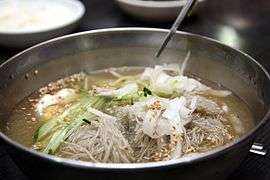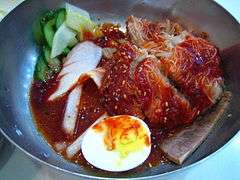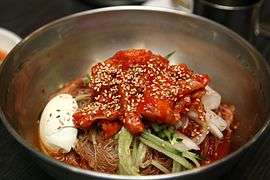Naengmyeon
Naengmyeon[2] (냉면; 冷麵, in South Korea) or raengmyŏn (랭면, in North Korea) is a Korean noodle dish of long and thin handmade noodles made from the flour and starch of various ingredients, including buckwheat (메밀, memil), potatoes, sweet potatoes, arrowroot starch (darker color and chewier than buckwheat noodles), and kudzu (칡, chik). Buckwheat predominates (despite the name, it is not a wheat but rather is more closely related to sorrel). Other varieties of naengmyeon are made from ingredients such as seaweed and green tea.
.jpg) A bowl of naengmyeon | |
| Alternative names | Raengmyŏn, cold noodles |
|---|---|
| Type | Guksu |
| Place of origin | Korea |
| Region or state | Pyongyang, Hamhung (N. Korea) Jinju (S. Korea) |
| Associated national cuisine | Korea |
| Serving temperature | Cold |
| Main ingredients | Noodles (flour and starch of buckwheat, potatoes, sweet potatoes) |
| Variations | Mul-naengmyeon, bibim-naengmyeon, hoe-naengmyeon |
| 110 kcal (461 kJ)[1] | |
| Korean name (South Korea) | |
| Hangul | |
|---|---|
| Hanja | |
| Revised Romanization | Naengmyeon |
| McCune–Reischauer | Naengmyŏn |
| IPA | [nɛŋ.mjʌn] |
| Korean name (North Korea) | |
| Chosŏn'gŭl | |
|---|---|
| Hancha | |
| Revised Romanization | Raengmyeon |
| McCune–Reischauer | Raengmyŏn |
| IPA | [ɾɛŋ.mjʌn] |
History
According to the 19th-century documents of Dongguksesigi (동국세시기, 東國歲時記), naengmyeon has been made since the Joseon Dynasty.[3] Originally a delicacy in northern Korea, especially in the cities of Pyongyang (평양) and Hamhung (함흥)[4] in North Korea, naengmyeon became widely popular throughout Korea after the Korean War.[3]
Naengmyeon is served in a large stainless-steel bowl with a tangy iced broth, julienned cucumbers, slices of Korean pear, thin, wide strips of lightly pickled radish, and either a boiled egg or slices of cold boiled beef or both. Spicy mustard sauce (or mustard oil) and vinegar are often added before consumption. Traditionally, the long noodles would be eaten without cutting, as they symbolized longevity of life and good health, but servers at restaurants usually ask if the noodles should be cut prior to eating, and use scissors to cut the noodles.
Varieties
The two main varieties of naengmyeon are mul naengmyeon (물 냉면) and bibim naengmyeon (비빔 냉면). The former is served as a cold soup with the noodles contained in broth made from beef, chicken or dongchimi. The latter is served with a spicy dressing made primarily from gochujang (red chili paste) and eaten all mixed. In the case of bibim naengmyeon, a bowl of the soup broth used in mul naengmyeon or plain broth from the boiled noodles itself are often served on the side. This broth can be served hot or cold depending on the restaurant and type of broth. Also boiled eggs and sliced cucumber are add as garnish.
Mul naengmyeon originates from Pyongyang.[5] Pyŏngyang naengmyŏn is mainly made from buckwheat and the broth of beef or pheasant. It also uses dongchimi broth or a mixture of it, while adding the sliced pieces of the radish to the dish. Vinegar, mustard oil (provided on request at most restaurants), and sugar is added according to taste before eating. South Koreans do not add sugar and use beef broth exclusively. In South Jeolla Province, mul naengmyeon is often served with red chili paste that is mixed in with the broth. The effect is similar to adding the broth to a bowl of bibim naengmyeon.
A version of bibim naengmyeon originates from Hamhung,[6] the hwe naengmyeon (회 냉면). Hwe naengmyeon is bibim naengmyeon with additional marinated raw fish (hwe), usually skate. It is eaten with the spicy gochujang dressing and other ingredients all mixed. Vinegar, sugar, and sometimes sesame oil is added according to taste. The noodles of Hamhung naengmyeon are usually made from potato or sweet potato starch, so the noodles are very chewy in texture compared to those of Pyongyang naengmyeon. In addition to skate, pollock (명태) can also be used in hwe naengmyeon. In this case it is referred to as myeongtae hwe naengmyeon (명태회냉면).
Another variety of naengmyeon is yeolmu naengmyeon (열무 냉면) which is served with yeolmu kimchi.
Jungguk-naengmyeon (중국냉면) is a Chinese-influenced cold noodle soup in Korean Chinese cuisine.
Morioka reimen (盛岡冷麺) is derived from naengmyeon which was introduced by Korean immigrants, part of Japanese regional cuisine in Tohoku region.
Instant naengmyeon noodles are available, with the soup broth prepackaged with the noodles. A plastic package of mustard oil is often supplied.
Gallery
.jpg)
.jpg)
 Mul-naengmyeon
Mul-naengmyeon
(물냉면) Bibim-naengmyeon
Bibim-naengmyeon
(비빔냉면) Hoe-naengmyeon
Hoe-naengmyeon
(회냉면)
In popular culture
In the South Korean variety show Infinite Challenge, Park Myeong-su and Jessica, a former member of Girls' Generation, performed the song "Naengmyeon" which was named after the food. The song became a hit and received wide acclaim.[7] The plot of the 2020 daily soap opera Brilliant Heritage revolves around a naengmyeon shop, among other riches owned by an 80-year old man who marries a 33-year old woman to spite his children.
In politics
During the first summit between North and South Korean leaders, Kim Jong-un and Moon Jae-in, Kim presented Moon with Pyongyang-style raengmyŏn as a gift.[8]
See also
References
- "mul-naengmyeon" 물냉면. Korean Food Foundation (in Korean). Retrieved 16 May 2017.
- (in Korean) "주요 한식명(200개) 로마자 표기 및 번역(영, 중, 일) 표준안" [Standardized Romanizations and Translations (English, Chinese, and Japanese) of (200) Major Korean Dishes] (PDF). National Institute of Korean Language. 2014-07-30. Retrieved 2017-02-15. Lay summary.
- "Naengmyeon". Retrieved 7 September 2015.
- Herald, The Korea (2018-04-20). "[Weekender] Pyongyang vs. Hamhung: Naengmyeons of Korea". www.koreaherald.com. Retrieved 2020-06-18.
- Pyongyang naengmyeon Doosan Encyclopedia
- Hamhung naengmyeon, Doosan Encyclopedia
- Naengmyeon wins award, Newsen
- "'Cold noodles are peace symbol': summit to savour for euphoric Koreans". The Guardian. Retrieved 2018-04-28.
External links
| Wikimedia Commons has media related to Naengmyeon. |
.jpg)